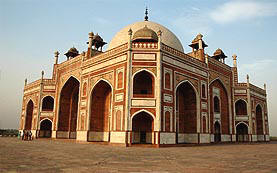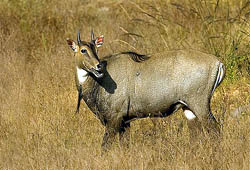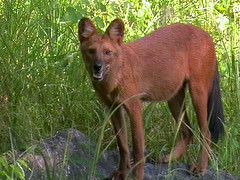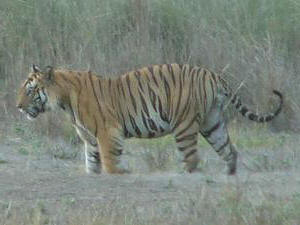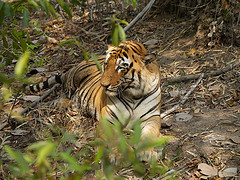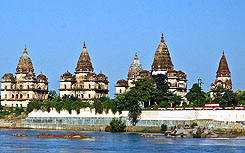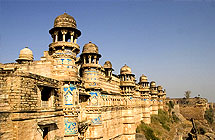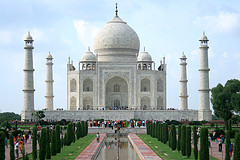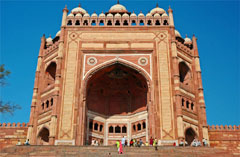|
Day 01 : Arrival Delhi
Arrive Delhi by international flight.
Meeting and assistance on arrival and transferred to the hotel.
Overnight at the hotel
Day 02 : Delhi - Sightseeing
After breakfast our tour guide takes
you for full day sightseeing tour of New Delhi and Old Delhi New Delhi
visit includes Qutab Minar, one of the earliest remains of Imperial
Delhi (13th century AD) Humayun's Tomb-the fine monument believed to
be forerunner of Taj Mehal, India Gata, the 42 metre high arch was
raised as a memorial to soldiers, drives past Parliament House,
President's House, Secretariat Building, Laxminarayan Temple and The
Connaught Place. Overnight stay at Delhi.
Day 03 : Delhi - Nagpur: Distance: 950 km Time
After breakfast transfer to Rly St. to board in Train for Nagpur. Over
night in Train.
Day 04 : Nagpur - Pench National Park: Distance: 105 km Time: 2
Hours
Arrive Nagpur & leave for Pench National Park. Arrive & chek inn.
After noon Safari in the Park. Overnight stay at hotel.
Day 05 : Pench - Kanha: Distance: 225 km Time: 5 Hours
After breakfast leave for Kanha. Kanha has sometimes been called the
N'Gorongoro of India. The simile is apt, albeit Kanha is far greener
and its cordon of hills far more densely wooded. Unlike Tanzania's
N'Gorongoro, the Kanha valley is not a volcanic crater, though the
enclosing hills are a consequence of geologically ancient volcanic
activity. The horseshoe-shaped Kanha valley, which accounts for nearly
a third and the oldest part of the Kanha National Park, is bound by
two distant spurs emanating from the main Mekal ridge, forming its
southern rim. The spurs, in their gently tapering traverse, nearly
close in the north leaving but a narrow opening for the meandering
Sulkum or Surpan river, the valley's main drainage. Herds of the Kanha
miscellany, the axis deer (chital), the swamp deer (barasingha), the
blackbuck (hiran), the wild pig and occasionally the gaur, throng the
central parkland of the valley, providing the basis for the
comparison with N'Gorongoro. With its confiding herds and relatively
tolerant predators, Kanha offers an almost unrivaled scope to a keen
photographer of Indian wildlife.
Evening safari at the Park. Overnight stay at hotel.
Day 06 : Kanha National Park
Morning & Afternoon safari at the park. Overnight stay at hotel.
Day 07 : Kanha - Bhandhavgarh National Park: Distance: 270 km Time: 5
Hours
After breakfast leave for Bandhavgarh. Arrive & check In to the Hotel.
Bandhavgarh national park have a very long history. Set among the
Vindhya hills of Madhya Pradesh with an area of 168 sq miles (437 sq
km), it contains a wide variety of habitats and a high density of
game, including a large number of tigers. Bandhavgarh was declared
Project Tiger Reserve in 1993. Bandhavgarh national park have a very
long history. Set among the Vindhya hills of Madhya Pradesh with an
area of 168 sq miles (437 sq km), it contains a wide variety of
habitats and a high density of game, including a large number of
tigers. Bandhavgarh has been a center of human activity and settlement
for over 2000 years. Legend has it that Rama, hero of the Hindu epic,
the Ramayana, stopped at Bandhavgarh on his way back to his homeland
after defeating the demon king Ravana of Lanka. Two monkey architects,
who had engineered a bridge between the isle of Lanka and the
mainland, are said to have built Bandhavgarh's fort. Later Rama handed
it over to his brother Lakshmana who became known as bandhavdhish,
"the lord of the fort" - a title still used by the present "lord of
the fort," the former Maharaja of Rewa. Lakshmana is the particular
god of the fort and is regularly worshiped in a temple there. In the
Bandhavgarh you can also enjoy tigers sighting from elephant back.
Government elephants belonging to the Forest Department and equipped
with walkie-talkies also in Bandhavgarh. However, there are many
tigers in the park and elephants are able to take you up steep, rocky
hillsides and down marshy riverbeds which are impassable to vehicles.
Overnight stay at hotel.
Day 08 : Bhandhavgarh
Morning & Afternoon safari at the park. Overnight stay at hotel.
Day 09 : Bhandhavgarh - Panna: Distance: 225 km Time: 5 Hours
Morning safari at the park. After Lunch leave for Panna. Tiger the
king of the jungle, roams freely in this secure, though a bit small
habitat alongwith his fellow beings - Leopard (Panther pardus), Wild
Dog (Cuon alpinus), Wolf (Canis lupus), Hyaena (Hyaena hyaena) and
Caracal (Felus caracal), smaller Cats., Sloth Bear, Sambar - the
largest of Indian Deers, Chital and Chowsingha, Nilgai and Chinkara
and reptiles including the python and crocodiles.
Birdwatchers - The forests at Panna, as well as the water dams are a
bird haven for migratory as well as the local birds which number over
300 and include the Shy paradise fly catcher, the rare Serpent Eagle,
white necked Stork, barheaded Goose, honey Buzzard, king Vulture,
blossom headed Parakeet, slaty headed Scimitar Babbler, and the
spectacular varieties of Kingfisher. A large number of birds are
spotted in the park. Evening safari at the park.
Overnight stay at hotel.
Day 10 : Panna - Khajuraho: Distance: 50 km Time: 1 Hours
Morning safari at the park. After breakfast leave for Khajuraho.
Arrive & check inn at the hotel. Khajuraho - a small town located in
the heart of India and famous for its erotic temples which were built
by the Chandela rulers in a short span of 100 years from 950-1050 AD
Out of 85 only about 20 have survived the ravages of time. Temples
here fall in three distinct groups namely western, eastern & southern
and belong to two different religions - Hinduism and Jainism. These
Hindu temples with erotic carvings were built 1000 years ago with art
and architecture merged to perfection. The temples are in three groups
in an area of about 8 square miles. The western group, largest and
most important, the eastern group is that of the Brahmin and Jain
shrines close to the present Khajuraho village and the Southern group
which houses the Chaturbhuj temple. Visit Western & Eastern Temple.
Overnight stay at hotel.
Day 11 : Khajuraho - Orchha: Distance: 155 km Time: 3 Hours
After break fast leave for Orcha. Arrive & check in to the Hotel.
After lunch half day city tour. Overnight stay at hotel.
Day 12 : Orchha - Agra via Gavaliar: Distance: 230 km Time: 5 Hours
After breakfast leave for Agra. On rout visit Gvaliar Fort.
A medieval city on the banks of the Yamuna River. It was founded by
Sultan Sikandar Lodi in the year 1506. Agra achieved fame as the
capital of the Mughal emperors from 1526 to 1658 and remains a major
tourist destination because of its many splendid Mughal-era buildings.
Most notably the Taj Mahal, Agra Fort and Fatehpur Sikri, all three of
which are UNESCO World Heritage Sites.
Overnight stay at hotel.
Day 13 : Agra
Agra Fort was originally a brick fort and the Chauhan Rajputs held it.
It was mentioned for the first time in 1080 AD when a Ghaznavide force
captured it. Sikandar Lodi (1487-1517) was the first Sultan of Delhi
who shifted to Agra and lived in the fort. He governed the country
from here and Agra assumed the importance of the second capital. He
died in the fort in 1517 and his son, Ibrahim Lodi, held it for nine
years until he was defeated and killed at Panipat in 1526. He built
several palaces, wells and a mosque in the fort during his period.
World famous monument The Taj Mahal, Overlooking the River Yamuna, the
Taj Mahal is a classic example of Mughul architecture, with the Taj
itself built as a mausoleum at the northern end of an extensive formal
walled garden designed in the charbagh style and structured on the
Islamic theme of 'paradise'. The whole site was built by Shah Jahan
between ad 1632 and 1653 as the final resting place of his favourite
wife Arjumand Bano Begum (also known as Mumtaz Mahal) who died in ad
1631 shortly after giving birth to their fourteenth child. Upon his
death in ad 1666, Shah Jahan was buried alongside his wife in the Taj.
(Closed on Fridays). Overnight stay at hotel.
Day 14 : Agra - Delhi Fatahpur Sikiri
After breakfast leave for Delhi. On rout visit Fatahpur Sikiri.
Fatehpur Sikri, which is a beautiful and deserted medieval city, built
by Mughal Emperor Akbar the Great in the 16th century to serve as the
capital of his vast empire. It was mysteriously abandoned after 15
years due to scarcity of water. Today, it is perfectly preserved as a
ghost city built at the height of the empire's splendor. See
Darbar-e-Aam, Palaces, Panch Mahal Taansen Seat & great Sufi Sent doom
etc.
After Lunch leave for Agra and evening check in hotel New Delhi
Overnight stay at hotel.
Day 15 : Delhi
After Breakfast. Visit Delhi Local Sight-seeing & evening drop to
airport, from where you will catch a flight to your destination. |
|


 Have a query about your booking?
Have a query about your booking?

